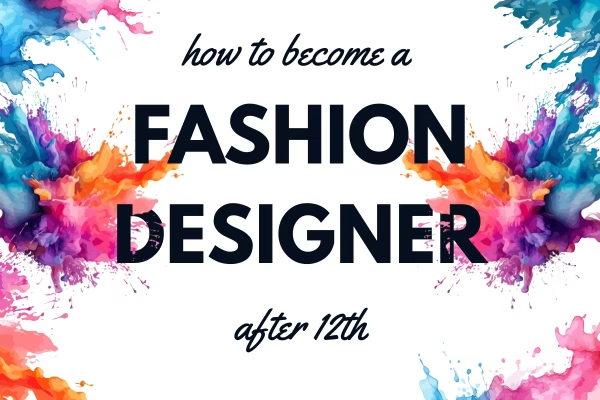So, you’ve finished your 12th-grade exams, and the world of fabrics, silhouettes, and style is calling your name? You’re not just someone who likes clothes; you see stories in stitches and art in apparel. The dream of becoming a fashion designer is an exciting one, a path filled with creativity, innovation, and the chance to make your mark on the world. But it can also seem like a maze. Where do you even begin?
Don’t worry. This is your ultimate, step-by-step guide for 2025 on exactly how to become a fashion designer after 12th. We’ll break down everything from the raw talent you need to cultivate, the best educational paths to pursue, the secrets to creating a portfolio that gets you noticed, and the strategies for landing that first dream job in the competitive fashion industry.
First Things First: Do You Have What It Takes?
Before diving into college applications and dreaming of Fashion Week, let’s get real about the core skills every successful fashion designer needs. This isn’t just about sketching pretty dresses; it’s a demanding profession that requires a unique blend of artistic creativity and sharp technical know-how.
Essential Skills for a Fashion Designer:
- Creativity and Artistic Vision: This is the soul of a designer. It’s your unique point of view, your aesthetic, your story. Can you look at a painting, a piece of architecture, or a historical event and translate it into a cohesive collection? This is about more than just trends; it’s about creating them.
- Strong Drawing and Sketching Skills: You must be able to communicate your vision on paper quickly and effectively. Your sketches are the language you use to speak to pattern makers, clients, and your team. Start practicing your fashion illustration now, focusing on proportions, movement, and how fabric drapes on the human form.
- Deep Understanding of Color, Texture, and Fabric: A designer’s true medium is fabric. You need a deep, almost intuitive knowledge of how different materials behave. How does silk charmeuse drape differently from heavy wool? What’s the difference between jacquard and brocade? This knowledge is crucial for bringing your designs to life as you imagined them.
- Sewing and Garment Construction Skills: You don’t have to be a master tailor, but you absolutely must understand how clothes are made. Knowing the fundamentals of pattern making, draping, and sewing will make you a better designer because you’ll understand the possibilities and limitations of construction. This technical foundation is non-negotiable.
- Clear Communication Skills: Fashion is a collaborative industry. You’ll be working with pattern makers, textile suppliers, models, photographers, and clients. The ability to clearly articulate your ideas, give constructive feedback, and negotiate is essential to bringing a collection from concept to reality.
- Business Acumen: Whether you work for a major brand or start your own fashion label, fashion is a business. Understanding marketing, branding, finance, profit margins, and supply chain management is vital. Especially if you dream of your own brand, you’ll need to be as much an entrepreneur as you are an artist.
The Big Question: Degree or Diploma? Choosing Your Educational Path
After the 12th, you have several options for formal education. This is one of the most important career options in fashion design, as it will provide you with the foundation for your entire career.
Bachelor’s Degree in Fashion Design (3-4 Years)
This is the most comprehensive and respected route. A Bachelor of Design (B.Des) or a similar degree offers in-depth knowledge of design theory, fashion history, technical skills, and crucial business management principles.
- Top Colleges: In India, look for prestigious institutions like the National Institute of Fashion Technology (NIFT), National Institute of Design (NID), and Pearl Academy. Internationally, schools like Parsons (New York), Central Saint Martins (London), and FIT (New York) are world-renowned.
- Entrance Exams: Be prepared for highly competitive entrance exams. The NIFT entrance exam, for example, typically consists of a Creative Ability Test (CAT) to evaluate your artistic skills and a General Ability Test (GAT) to assess your quantitative, analytical, and communication skills. Start preparing early!
- Curriculum: You’ll study everything from fashion illustration and pattern making to textile science, fashion history, and brand management. Many programs also offer specializations in areas like knitwear design, leather design, or menswear.
- Best for: Students who want a deep, well-rounded education and access to the best industry connections, internships, and placement opportunities. A degree often opens doors to higher-level positions.
Diploma in Fashion Design (1-2 Years)
A diploma is a shorter, more focused program that zeroes in on the practical, technical skills needed to work in the industry. It’s less about theory and more about doing.
- Who is it for? It’s a great option if you want to get into the industry quickly, if you’re looking for a more affordable path, or if you want to test the waters before committing to a full degree.
- What you’ll learn: These courses are heavy on the “how-to.” Expect intensive training in pattern making, sewing, draping, and industry-standard software like Adobe Illustrator and Photoshop for creating technical flats and digital illustrations.
- Career Path: A diploma can lead directly to jobs like assistant designer, pattern maker, or production assistant.
Long-tail keyword to note: Many students search for “fashion designing courses after 12th commerce” or “fashion designing courses after 12th science.” The good news is that your 12th-grade stream rarely matters. Fashion design entrance exams focus on your creativity and aptitude for design, making it a viable path for students from all academic backgrounds.
Your Secret Weapon: Building a Killer Fashion Design Portfolio
Your portfolio is your single most important asset. It’s a visual resume that showcases your skills, creativity, and potential. It does more than just show your work; it tells the story of who you are as a designer. You should start building it now, even before you get into college.
How to Create a Fashion Design Portfolio for Beginners:
- Show Your Entire Process: Don’t just include the final, polished illustrations. A great portfolio reveals your thought process. For each project, include your initial inspiration (a mood board with images, textures, and colors), your first rough sketches, fabric swatches, and photos of any garments you’ve actually sewn. This shows a potential college or employer how you think and solve problems.
- Demonstrate Range and a Cohesive Vision: Include a variety of projects to show your versatility. This could be a 3-5 piece mini-collection based on a theme, a technical project focusing on a specific sewing technique (like corsetry or tailoring), or even an upcycling project where you deconstruct and redesign an existing garment. While showing range, make sure the portfolio has a consistent aesthetic that reflects your unique style.
- Quality Over Quantity: This is a golden rule. It’s far better to have 10-15 pages of your absolute best, most thoughtful work than 50 pages of mediocre sketches. Every single page should be something you are proud of and that demonstrates a specific skill or idea. Edit mercilessly.
- Digital and Physical are Both Essential: In today’s world, you need both. Have a professional, beautifully presented physical portfolio for in-person interviews. For this, invest in a good quality portfolio case. Simultaneously, create a high-quality digital version—either as a polished PDF or, even better, a simple personal website. This allows you to apply for opportunities online easily and shows your digital literacy.
Get Your Foot in the Door: The Power of Internships
Real-world experience is invaluable and non-negotiable. A fashion internship for students is your chance to see how the industry really works, beyond the glamour of the runway.
- When to Start: Begin looking for internships aggressively during your second or third year of college. Use your college’s placement cell, professional networking sites like LinkedIn, and don’t be afraid to directly contact designers or brands you admire.
- What You’ll Actually Do: Be prepared to work hard. You might be assisting designers with research, sourcing fabric swatches, organizing samples, helping to dress models at photoshoots, or even doing basic sewing and finishing tasks. No task is too small.
- The Real Benefit: The connections you make are priceless. You’ll learn practical skills you can’t get in a classroom, like how to work under pressure and meet tight deadlines. An internship is the best way to bridge the gap between being a student and becoming a professional, and a good reference can be the key to your first job.
Launching Your Career: What’s Next?
After graduation and a few internships, you’re ready to take the final, exciting step into your professional career. The path you choose will depend on your personality, goals, and financial situation.
- Get a Job and Climb the Ladder: The most common path is to work for an established brand or designer. You’ll likely start as an assistant designer, a pattern maker, a fashion illustrator, or a merchandiser. This is an incredible opportunity to learn from experienced professionals, understand the business side of a large company, and refine your skills without the financial risk of starting your own business.
- Start Your Own Label: If you have a strong, unique business plan and a clear brand vision, you might consider launching your own brand. This is the ultimate dream for many, but it is incredibly challenging. Be prepared to be more than a designer; you’ll be the CEO, head of marketing, production manager, and accountant. You’ll need to handle everything from design and production to branding, social media, and sales. It’s a high-risk, high-reward path that requires immense dedication.
Becoming a fashion designer is a journey of passion, resilience, hard work, and continuous learning. The industry is always evolving, so a successful designer never stops growing. Start today by honing your skills, researching colleges, and building that all-important portfolio. The runway is waiting for you!



